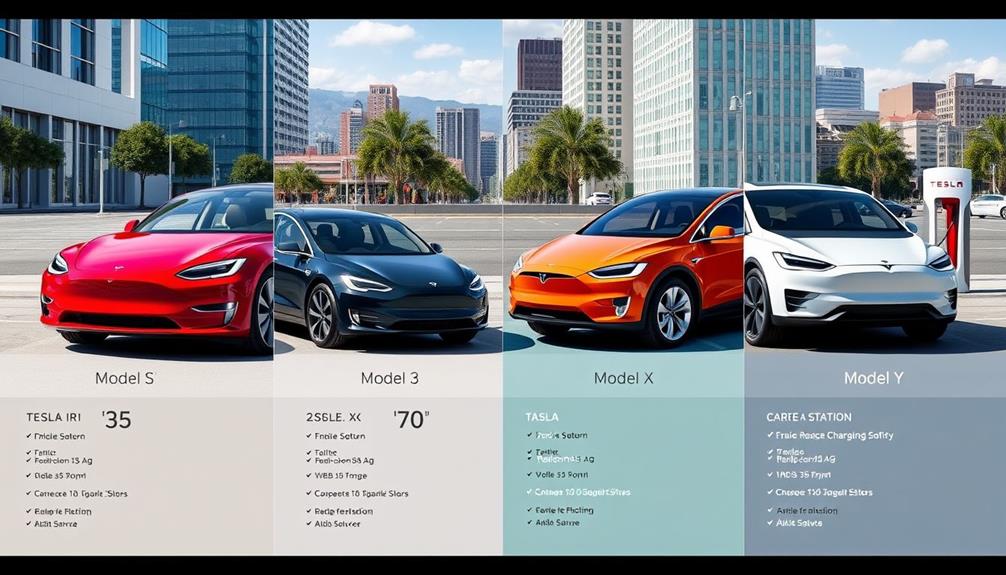You'll be impressed by how far a Tesla can go! The Model S boasts up to 402 miles per charge, while the Model 3 Long Range offers 341 miles. If you opt for the Model X or Model Y Long Range, expect around 336 and 310 miles, respectively. However, how far you actually travel can vary, influenced by driving conditions, speed, and even temperature. Charging isn't a hassle, thanks to over 30,000 Supercharger stations worldwide. Want to discover more about maximizing your Tesla's efficiency and range? There's so much more to explore about these innovative vehicles!
Key Takeaways
- The Tesla Model S offers an impressive range of up to 402 miles on a single charge, making it the leader in distance.
- The Model 3 Long Range achieves 341 miles, while the Model X and Model Y Long Range provide 336 and 310 miles, respectively.
- Real-world driving conditions and factors like speed, load, and temperature can significantly affect the effective range of Tesla vehicles.
- Tesla's extensive Supercharger network allows for quick charging, enabling long-distance travel with minimal downtime.
- Maintaining the battery's state of charge between 20% to 90% is recommended for optimal battery health and longevity.
Overview of Tesla Range

When you're considering an electric vehicle, Tesla's impressive range is a key factor that sets it apart from the competition.
The Tesla Model S, for instance, boasts a remarkable range of up to 402 miles on a single charge, making it perfect for long journeys.
If you're looking for something more compact, the Tesla Model 3 Long Range variant offers an efficient 341 miles, ideal for daily commutes and weekend getaways.
For those who need a bit more space without sacrificing efficiency, the Tesla Model Y Long Range provides an estimated range of 310 miles.
This electric SUV combines versatility with impressive mileage, catering to families and adventurers alike.
However, it's important to keep in mind that real-world driving conditions can influence these ranges.
For instance, highway driving may require charging every 150 miles for the Model Y, especially when considering aspects like speed and elevation changes.
Tesla Cybertruck Range Details

The Tesla Cybertruck offers impressive range options that cater to a variety of driving needs. The base model features a robust 123.0-kWh battery, providing an estimated range of 340 miles on a single charge, making it ideal for long trips or daily commutes.
If you opt for the Cyberbeast model, you'll get a slightly lower range of 320 miles, still powered by the same battery capacity.
For those looking to extend their driving adventures, the Cybertruck offers a Range Extender option that can add an extra 120-130 miles to your journey. This flexibility means you won't have to worry as much about charging stations when you're out on the road.
All-wheel drive is standard across all models, enhancing performance and traction in various driving conditions, whether you're traversing city streets or tackling rugged terrain.
The Cybertruck is engineered to accommodate diverse environments, ensuring that it can handle everything from urban commutes to off-road escapades.
With these range options, the Cybertruck truly stands out in the electric vehicle market, giving you the freedom to explore further.
Tesla Model Comparisons

Comparing Tesla models reveals a range of options tailored to different preferences and needs. Whether you prioritize luxury, space, or everyday efficiency, there's a Tesla for you. Here's a quick comparison of some popular models: The Tesla Model 3 is often praised for its affordability relative to other models, while still delivering impressive performance and range. However, when considering the **Tesla Model 3 pros and cons**, it’s important to note that its minimalist interior design might not appeal to drivers seeking high-end luxury, though it does offer a sleek, modern aesthetic. By contrast, the Model S offers more premium features and longer range but at a significantly higher price point.
| Model | Range (miles) |
|---|---|
| Tesla Model S | 402 |
| Model 3 Long Range | 341 |
| Model X | 336 |
| Model Y Long Range | 310 |
The Tesla Model S stands out with an impressive range of up to 402 miles, making it perfect for long trips. If you're looking for a balance of performance and efficiency, the Model 3 Long Range offers 341 miles, suitable for daily commuting. For those who need more space while still enjoying a decent range, the Model X delivers 336 miles of luxury and utility. Finally, the Model Y Long Range provides 310 miles, catering to families without compromising on driving distance. Each model showcases Tesla's commitment to innovation and range efficiency, ensuring you can find the perfect fit for your lifestyle.
Real-World Driving Experiences

When you hit the highway in your Tesla, you'll quickly realize that the real-world range can fall short of the EPA estimates.
Factors like driving conditions and elevation changes can greatly impact how far you can go on a single charge.
To make the most of your trip, it's essential to plan your charging stops and adjust your expectations accordingly.
Real-World Range Limitations
Many drivers find that Tesla's real-world range often falls short of EPA estimates, leading to unexpected challenges on the road. For instance, while the 2023 Model Y Long Range boasts an EPA range of 326 miles, you might realistically achieve only 175 to 200 miles under highway speeds. This discrepancy stems from various driving conditions and factors like load and energy consumption.
When you drive with a full load, including passengers and cargo, your range can diminish even further. You might find yourself needing to recharge 50 miles from home due to miscalculating the energy needed for your trip.
Additionally, using air conditioning or facing elevation changes can ramp up energy consumption; some trips show rates as high as 380 Wh/mile.
This variability can create range anxiety, especially on long journeys where planning is essential. Remember, energy efficiency can improve during downhill segments, so consider your route carefully.
Understanding these real-world range limitations can help you navigate your Tesla more effectively, ensuring that you're prepared for the unexpected when you hit the road.
Charging Infrastructure Importance
Having a reliable charging infrastructure is essential for any Tesla driver looking to maximize their driving experience. The Supercharger network plays a pivotal role, enabling quick recharges that can add 120-140 miles of range in just 10 minutes. However, pre-trip planning is vital to avoid miscalculations, especially on longer journeys, where elevation changes and vehicle load can impact energy consumption and range efficiency.
Here's a quick reference for key factors affecting your Tesla trip:
| Factor | Impact on Range | Tips for Optimization |
|---|---|---|
| Elevation Changes | Can decrease range | Plan routes with elevation in mind |
| Vehicle Load | Increases energy consumption | Travel light when possible |
| Charging Station Access | Critical for long trips | Use the Tesla app for planning |
| State of Charge (SoC) | 20%-90% for efficiency | Maintain SoC for battery health |
Driving Conditions Impact
Driving a Tesla under real-world conditions can greatly affect your range. While you might expect a fully charged Tesla Model Y to achieve an EPA estimated range of 326 miles, actual conditions often yield much less—sometimes between 175 and 200 miles on the highway. This discrepancy highlights how various driving conditions impact your energy consumption.
Consider these factors:
- Highway speeds: Driving faster typically increases energy consumption, reducing your range.
- Payload: Carrying extra weight, like multiple passengers or cargo, can considerably lower your overall range.
- Temperature: Extreme weather can also affect battery efficiency and energy usage.
For example, a 2018 Long Range RWD Tesla showed an actual consumption of 380 Wh/mile during a trip, starkly contrasting with its usual efficiency of 243 Wh/mile.
Elevation changes and driving habits further complicate matters. Without low rolling resistance tires, you might see an even greater impact on your actual range.
To maximize your Tesla's range, it's essential to strategize your trips and account for these driving conditions.
Factors Affecting Electric Range

When it comes to electric range, several factors can considerably impact how far your Tesla can go on a single charge.
First off, your driving speed plays a significant role. For instance, cruising at highway speeds of 75 mph can lead to higher energy consumption, reducing your effective mile range compared to more normal driving in the city.
Additionally, weight and load are essential. Carrying extra passengers or cargo can increase energy usage, further decreasing the distance you can travel on one charge.
Environmental factors also come into play; driving uphill can raise energy consumption by about 20 Wh/mile, and extreme temperatures can affect battery performance and efficiency.
Tire conditions shouldn't be overlooked either. Using non-low rolling resistance tires or having improper tire pressure can diminish your Tesla's range.
In real-world scenarios, you might find that your effective range is lower than EPA estimates. For example, a Tesla Model Y Long Range might realistically achieve around 175 to 200 miles under highway conditions, emphasizing the importance of these factors in your electric driving experience.
Charging Infrastructure and Tips

When you own a Tesla, understanding the charging infrastructure is key to maximizing your range.
You'll want to know where charging stations are located, how to charge efficiently, and what costs you might incur.
Charging Station Availability
Tesla's extensive Supercharger network, boasting over 30,000 stations worldwide, guarantees that you won't be left searching for charging options on your road trips.
This robust infrastructure allows long-distance travelers to enjoy their journeys without the worry of running out of battery. With many Tesla models capable of reaching up to 80% charge in just about 30 minutes at a Supercharger, you can make quick pit stops along the way.
To maximize your experience, keep these tips in mind:
- Use the Tesla mobile app to locate nearby charging stations with real-time availability updates.
- Plan your trips around charging points, as highway driving might require charging every 150 miles (240 km), depending on your model and driving conditions.
- Remember that Tesla vehicles can utilize both Supercharger stations and third-party charging networks, broadening your options.
With this thorough charging station availability, you'll have the confidence to explore further.
Just keep an eye on your driving range, and you'll be set for exciting adventures in your Tesla!
Optimal Charging Practices
Maximizing your Tesla's battery life and performance starts with understanding ideal charging practices. For peak battery health, aim to keep your state of charge (SoC) between 20% and 90%. This range not only enhances your Tesla's longevity but also guarantees you have enough charge for those longer trips.
When planning your routes, consider utilizing Tesla's Superchargers strategically. Charging typically slows down after reaching 80% SoC, so it's more efficient to stop for a quick top-up rather than waiting for a full charge. You can expect to gain about 80% in just 30 minutes, making Superchargers a convenient option for longer journeys.
At home, installing a charging unit allows you to charge overnight during off-peak hours, saving on costs and making sure your vehicle's always ready to go.
Don't forget to use real-time tracking apps to locate nearby charging stations and monitor your charging progress. This is vital for planning your road trips and maximizing your Tesla's range.
Cost of Charging
Understanding the cost of charging your Tesla can greatly affect your overall ownership experience. The cost of charging varies depending on where you plug in, typically ranging from $0.25 to $0.45 per kWh. If you utilize the extensive Supercharger network, you can expect to pay around $10 to $15 for 120-140 miles of range.
Here are a few tips to keep in mind:
- Home Charging: Installing a Level 2 charger allows you to gain about 30 miles of range per hour—perfect for overnight charging.
- Battery Health: Maintain your battery's state of charge (SoC) between 20% to 90% to guarantee ideal battery health and longevity.
- Monitor Costs: Use the Tesla app to keep an eye on charging station availability and real-time costs, helping you plan your trips better.
With these insights, you'll be better equipped to manage your charging costs while enjoying the benefits of electric cars.
Frequently Asked Questions
What Is the True Range of a Tesla?
The true range of a Tesla varies by model and conditions. For instance, you might find the Model S offers around 402 miles, while other models typically range from 303 to 341 miles under normal circumstances.
How Do You Find the Max Range on a Tesla?
To find your Tesla's maximum range, check the "Trip" feature on your touchscreen. It estimates energy use based on your driving conditions, helping you maximize efficiency and plan for your journey's needs effectively.
What Is the Highest Range on a Tesla?
The highest range on a Tesla is achieved by the Model S Dream Edition R, which can go up to 426 miles on a single charge. This impressive capability sets it apart from other models.
What Is the Real Range of the Tesla 3 Standard Range?
Think of cruising down an endless highway. The Tesla Model 3 Standard Range Plus typically gives you about 238 miles. With smart planning, you'll conquer those miles without breaking a sweat or feeling anxious.
Conclusion
To wrap it up, whether you're cruising in a Tesla Model S or eyeing the rugged Cybertruck, you'll find impressive ranges that fit your lifestyle. It's funny how you might worry about running out of juice, only to discover charging stations are often just around the corner—like bumping into an old friend when you least expect it. So, embrace the journey and let Tesla's technology take you farther than you ever thought possible!










